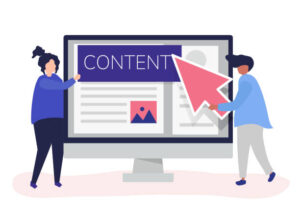Sometimes writing copy is the toughest part of creating effective content. There’s a lot to balance–using the right language and keywords, selecting the right channels, and keeping it all interesting. Let’s look at five winning copywriting tips to help make your content more effective!
Copywriting Tip 1: Keep it Simple
Who is your audience? The average person reads at the 7th to 8th-grade level, which means your long-winded copy is probably going to get skipped. Unless your audience is more educated or verbose, keep your copy simple and direct. Use short sentences, try to use commas instead of periods, and keep the fancy words to a minimum.
Even for longer copy, make sure to capitalize on headings, subheadings, and short paragraphs. Before your reader actually reads content, they scan it. If it’s a lot of words, they’ll skip it. If it’s formatted properly and “easy to read”, they’re more likely to give it a go.
In most cases, write the same way you talk. Don’t write words you wouldn’t use conversationally. Think of most content as a conversation with your audience. How can you make sure they feel respected and understand your messages?
Copywriting Tip 2: Don’t Overoptimize

Remember, your content should be written for humans, not computers. While it’s important to include the proper keywords for SEO purposes, forcing keywords not only makes the copy harder to read, it hurts your SEO efforts. Search engines can pick up when you’re trying to keyword-stuff–and they’ll penalize you for it.
Instead, try to incorporate the keyword(s) as often as you can–naturally. It’s okay to break up keywords or phrases with punctuation, articles, or prepositions, especially if it makes the copy read more naturally. Search engines can pick up on this and won’t penalize you for a slight alteration.
Titles, tags, and headings are also great places to capitalize on your short and long-tail keywords, so don’t try to stuff it all into the actual copy. This is most helpful for blogs–for longer, more specific keywords, it helps to put the blog title in the actual URL!
Copywriting Tip 3: Show What You Can Do For Your Audience
Your natural instinct might be to boast the accolades and accomplishments of your brand, but how does that help your audience? Rather than write what you’ve done, write what you can do for your audience. People are much more interested in what you can do for them, and in most businesses, past performance is only as good as the customer’s last experience.
Be direct in stating how your brand, products, or services can solve real problems and meet your audience’s needs. Instead of “our product is great for X,” try something like “Never deal with X again thanks to our product!”
If possible, personalize your copy–especially if it’s interpersonal communications like emails or push notifications. Even taking the time to include your customer’s name goes a long way.
Copywriting Tip 4: Start With a Hook

Scientists theorize that the human attention span is now shorter than that of a goldfish. Most people can’t pay attention to something for more than nine seconds, especially if they don’t find it interesting. Let’s face it: your customers probably won’t be inherently captivated by your marketing content. If you can hook them with the first sentence, however, they’re more likely to keep reading.
Capitalize on direct quotes, stories, statistics, and especially emotion. Copy that makes your reader feel something is more likely to inspire them to take action than something bland or uninspired. Plus, if nothing else, it’ll get them to pay attention!
Copywriting Tip 5: Inspire Action
Before you write any copy, ask yourself what the purpose is. What are you trying to do? Are you trying to raise awareness, build interest, or capture more conversions? Since the goal of your content is to drive action, your copy can make a difference. Always include a call to action and try to create a sense of urgency. Even if your offer isn’t time-sensitive, you don’t want a potential customer to think too long on it.
Lead your customers to take the logical next step and act as soon as possible. Otherwise, they’re likely to forget about your offer altogether, and when they finally decide to take action, it might not be with you.
Follow These Tips and Start Seeing Results!
Creating effective copy boils down to a few key components: keeping it simple, direct, and engaging. Hook your audience in the first sentence, keep them hooked by showing how you can improve their lives, and speak to them respectfully–and as a real person would.
If you follow these tips, you’ll create more effective copy–and you’ll start seeing more results, like improved engagement, more brand interest, and ultimately, more conversions!




